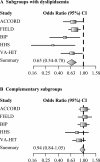Residual macrovascular risk in 2013: what have we learned?
- PMID: 24460800
- PMCID: PMC3922777
- DOI: 10.1186/1475-2840-13-26
Residual macrovascular risk in 2013: what have we learned?
Abstract
Cardiovascular disease poses a major challenge for the 21st century, exacerbated by the pandemics of obesity, metabolic syndrome and type 2 diabetes. While best standards of care, including high-dose statins, can ameliorate the risk of vascular complications, patients remain at high risk of cardiovascular events. The Residual Risk Reduction Initiative (R3i) has previously highlighted atherogenic dyslipidaemia, defined as the imbalance between proatherogenic triglyceride-rich apolipoprotein B-containing-lipoproteins and antiatherogenic apolipoprotein A-I-lipoproteins (as in high-density lipoprotein, HDL), as an important modifiable contributor to lipid-related residual cardiovascular risk, especially in insulin-resistant conditions. As part of its mission to improve awareness and clinical management of atherogenic dyslipidaemia, the R3i has identified three key priorities for action: i) to improve recognition of atherogenic dyslipidaemia in patients at high cardiometabolic risk with or without diabetes; ii) to improve implementation and adherence to guideline-based therapies; and iii) to improve therapeutic strategies for managing atherogenic dyslipidaemia. The R3i believes that monitoring of non-HDL cholesterol provides a simple, practical tool for treatment decisions regarding the management of lipid-related residual cardiovascular risk. Addition of a fibrate, niacin (North and South America), omega-3 fatty acids or ezetimibe are all options for combination with a statin to further reduce non-HDL cholesterol, although lacking in hard evidence for cardiovascular outcome benefits. Several emerging treatments may offer promise. These include the next generation peroxisome proliferator-activated receptorα agonists, cholesteryl ester transfer protein inhibitors and monoclonal antibody therapy targeting proprotein convertase subtilisin/kexin type 9. However, long-term outcomes and safety data are clearly needed. In conclusion, the R3i believes that ongoing trials with these novel treatments may help to define the optimal management of atherogenic dyslipidaemia to reduce the clinical and socioeconomic burden of residual cardiovascular risk.
Figures



References
-
- Nichols M, Townsend N, Luengo-Fernandez R, Leal J, Gray A, Scarborough P, Rayner M. European Cardiovascular Disease Statistics 2012. Sophia Antipolis: European Heart Network, Brussels, European Society of Cardiology; 2012.
-
- Lozano R, Naghavi M, Foreman K, Lim S, Shibuya K, Aboyans V, Abraham J, Adair T, Aggarwal R, Ahn SY, Alvarado M, Anderson HR, Anderson LM, Andrews KG, Atkinson C, Baddour LM, Barker-Collo S, Bartels DH, Bell ML, Benjamin EJ, Bennett D, Bhalla K, Bikbov B, Bin Abdulhak A, Birbeck G, Blyth F, Bolliger I, Boufous S, Bucello C, Burch M. et al.Global and regional mortality from 235 causes of death for 20 age groups in 1990 and 2010: a systematic analysis for the global burden of disease study 2010. Lancet. 2012;380:2095–2128. doi: 10.1016/S0140-6736(12)61728-0. - DOI - PMC - PubMed
-
- International Diabetes Federation. E-Atlas 6th edition. 2013. http://www.idf.org/diabetesatlas.
-
- Yusuf S, Hawken S, Ounpuu S, Dans T, Avezum A, Lanas F, McQueen M, Budaj A, Pais P, Varigos J, Lisheng L. INTERHEART Study Investigators. Effect of potentially modifiable risk factors associated with myocardial infarction in 52 countries (the INTERHEART study): case–control study. Lancet. 2004;364:937–952. doi: 10.1016/S0140-6736(04)17018-9. - DOI - PubMed
Publication types
MeSH terms
LinkOut - more resources
Full Text Sources
Other Literature Sources
Medical
Molecular Biology Databases
Research Materials

